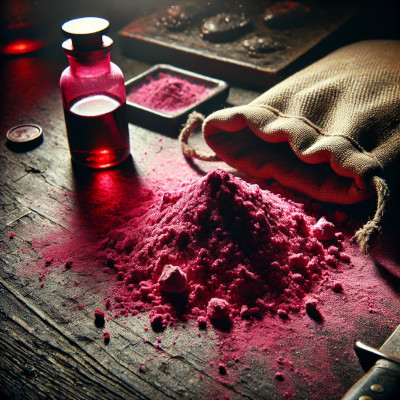Pink cocaine, despite its misleading name and colorful appearance, is a highly dangerous synthetic drug made from a mix of substances like 2-CB, ketamine, MDMA, methamphetamine, and caffeine. It's popular in nightlife settings but is unpredictable and carries severe health risks such as the potential for overdose, heart problems, and mental health issues. The ingredients can vary greatly between batches, increasing the risks for users and highlighting the importance of awareness and caution.
4 min to read
Pink Cocaine: What You Need to Know About This Trending Drug
Pink cocaine, also known as "tusi/tuci" or "tucibi," is an emerging, dangerous synthetic drug that has gained popularity in Latin America and has spread globally. Despite the name, pink cocaine rarely contains cocaine. Instead, it’s a cocktail of synthetic drugs, often dyed pink and flavored to appeal to clubgoers. Understanding pink cocaine's composition, effects, and risks is crucial, as the drug’s unpredictable nature makes it extremely dangerous.
What Is Pink Cocaine?
The term “pink cocaine” refers to a powder or pill that’s often bright pink due to added dyes, with an occasional fruity or strawberry scent. Unlike traditional cocaine, pink cocaine is a mixture of cheaper, synthetic drugs. The primary ingredients include:
- 2-CB: A hallucinogen that causes visual and sensory distortions.
- Ketamine: A dissociative anesthetic with hallucinogenic effects.
- MDMA (Ecstasy): Known for its euphoric effects and stimulant properties.
- Methamphetamine: A potent stimulant that can lead to severe addiction.
- Fentanyl: A potent synthetic opioid, often used as a painkiller in medical settings.
- Xylazine: A veterinary sedative often used as a muscle relaxant for animals. It is not approved for use in humans.

Other substances like benzodiazepines, bath salts, and even caffeine are also found in some pink cocaine batches, increasing the danger for users.
Origins and Global Spread
Initially popularized in Colombia, pink cocaine gained traction as a luxury party drug among affluent users in Latin American clubs, eventually spreading to Europe and North America. Known by names like “tusi” and “cocaina rosada,” it’s popular in nightlife venues, especially in electronic music scenes. Reports from Spain indicate that its exclusivity is a misconception, as it’s often made with inexpensive drugs, marketed at high prices to create an illusion of exclusivity.
How Pink Cocaine Differs from Traditional Cocaine
Unlike cocaine, which is a pure stimulant derived from coca leaves, pink cocaine is a synthetic mix and unpredictable. It provides a mix of stimulant and hallucinogenic effects, distinct from the purely energizing effects of cocaine. While cocaine typically creates a rush of energy and alertness, pink cocaine’s blend of sedatives, stimulants, and psychedelics makes its effects highly variable and dependent on the specific substances and doses present in each batch.
Effects and Experiences
The appeal of pink cocaine lies in its ability to induce euphoria, sociability, and sensory enhancement. [1] Common effects include:
Users report feelings of pleasure, social openness, and increased empathy.
Users often feel heightened emotions, empathy, and pleasure, similar to MDMA or ecstasy.
Particularly due to ketamine, users may experience out-of-body sensations or altered perceptions.
Elevated heart rate, blood pressure, nausea, and dehydration are common. Users also risk confusion, panic, and psychotic episodes if taken in high doses.
Effects can last between 4-6 hours but vary widely depending on the drug composition. Mixing pink cocaine with alcohol or other drugs intensifies its risks, particularly as ketamine and alcohol can lead to blackout or loss of motor control.
Health Risks and Dangers
The biggest concern with pink cocaine is its unpredictable composition. Each batch varies in ingredients and potency, making it akin to “Russian Roulette.” [2] Adverse effects include:
Increased heart rate, hypertension, and even heart attacks can occur, especially with high doses of stimulants like methamphetamine.
Anxiety, paranoia, and psychosis are common, particularly after prolonged or high-dose use.
The combination of MDMA and other serotonin-boosting substances can lead to dangerous serotonin syndrome, causing confusion, muscle rigidity, and in severe cases, seizures or death.
Repeated use has been linked to cardiovascular issues, stroke risk, persistent anxiety, behavioral changes, and, in some cases, addiction.
Addiction and Dependency Potential
While pink cocaine isn’t as addictive as heroin or crack, users can develop psychological dependency, especially in party settings where it is often used. The dopamine and serotonin release can lead to cravings and an urge to re-experience the euphoric effects, particularly when combined with other addictive substances like methamphetamine.
Increased Overdose Risk
With unpredictable ingredients, overdoses are common. Symptoms of a pink cocaine overdose include extreme agitation, hallucinations, seizures, and in severe cases, coma or respiratory failure. In cases of suspected overdose, emergency services should be contacted immediately. If opioids are present in the mix, administering naloxone (Narcan) can be lifesaving, though it will not address non-opioid effects.
Signs of Overdose and When to Seek Help
Symptoms of a pink cocaine overdose can include severe agitation, confusion, high blood pressure, and seizures. In these cases, immediate medical attention is essential. Users or bystanders are encouraged to administer naloxone in suspected opioid-related incidents and call emergency services if severe symptoms are present.
Law Enforcement and Drug Seizures
Law enforcement agencies in the U.S., Spain, and Latin America have seized large quantities of pink cocaine in recent years. [3] Authorities have noted an increase in pink cocaine trafficking from Latin America, often smuggled alongside traditional drugs. There is a growing concern that fentanyl, a potent synthetic opioid, may begin appearing in pink cocaine batches, further increasing the risk of fatal overdoses.
Conclusion
Pink cocaine is a misleading and highly dangerous synthetic drug, marketed as a luxury item but often composed of low-cost, high-risk substances. Its variable composition makes it highly unpredictable, and its mixture of hallucinogens, stimulants, and depressants creates serious health hazards, particularly in nightlife settings. Awareness of its dangers and the potential for accidental overdose is essential for those who encounter this drug. For anyone struggling with dependency or adverse health effects from synthetic drugs, professional treatment and counseling are strongly recommended.
Concerned about the dangers of pink cocaine? Tulua Health offers expert addiction treatment and support. If you or someone you know is struggling with synthetic drug use, explore our specialized programs and begin your journey to recovery.
Discussion
Safe, Nurturing, Healing
Tulua Health is More Than a Recovery Center
Safety and support form the cornerstone of recovery at Tulua Health. We offer a nurturing environment that extends beyond treatment. Our facilities boast modern amenities, ensuring privacy, comfort, and a range of supportive programs. Here, every aspect of our sober living homes is designed to provide you with a sanctuary that you can proudly call home.
We Accept Many Health Plans





It Starts here
Get a Free Health Coverage Verification
Wellness doesn't just happen. Our team of behavioral health specialists can help find the plan that is right for you. If you're ready for a new start, click below to submit a free health insurance verification request.



